Assessing the Quality of the Leica BLK2GO Mobile Laser Scanner versus the Focus 3D S120 Static Terrestrial Laser Scanner for a Preliminary Study of Garden Digital Surveying
Abstract
1. Introduction
2. Materials and Methods
2.1. Data Acquisition
2.1.1. Scanners’ Characteristics
2.1.2. Site Activities
2.1.3. Point Cloud Processing and Registration
2.2. Analysis Setup
2.2.1. Scans Coordinate Systems
2.2.2. Scope Area
2.2.3. Point Cloud Information
2.2.4. Cloud Deviation
3. Results
3.1. Data Comparison
3.1.1. Tree Canopy
3.1.2. Terrain and Contour Lines
3.1.3. Trunk Diameter at Breast Height
3.1.4. Under-Canopy Data Completeness
4. Discussion
- -
- Creating a digital terrain model (DTM) from the point cloud (A); shifting the created DTM by a certain Z value to correspond to the level (distance from the ground) on which the trunks will be cut and the trunk diameter will be extracted.
- -
- Splitting the point cloud to get a point cloud slice with a defined thickness (a suggested value of 0.05 m) on the shifted DTM (A).
- -
- Isolating the created slice representing the trunk cuts and dividing the point cloud into portions corresponding to each trunk—it is used “split by distance” for this process with a value set at 0.05 m (A). Trunks too close to each other must be separated manually.
- -
- Running the automatic extraction of “circles,” selecting all the point clouds that correspond to all the trunks (A), and sending directly the “circles” to Autodesk AutoCAD.
5. Conclusions
Author Contributions
Funding
Institutional Review Board Statement
Informed Consent Statement
Data Availability Statement
Acknowledgments
Conflicts of Interest
References
- Machat, C.; Ziesemer, J. Heritage at Risk. World Report 2016–2019 on Monuments and Sites in Danger. Hendrik BÄßLER Verlag. 2020. Available online: https://www.icomos.de/icomos/pdf/hr20_2016_2019.pdf (accessed on 21 December 2022).
- World Meteorological Organization. WMO Atlas of Mortality and Economic Losses from Weather, Climate and Water Extremes (1970–2019); World Meteorological Organization: Geneva, Switzerland, 2021; ISBN 978-92-63-11267-5. Available online: https://library.wmo.int/doc_num.php?explnum_id=10989 (accessed on 21 December 2022).
- Mitchell, N.; Rössler, M.; Tricaud, P.M. World Heritage Cultural Landscapes: A Handbook for Conservation and Management; World Heritage Series: 26; UNESCO: Paris, France, 2009; Available online: https://unesdoc.unesco.org/ark:/48223/pf0000187044 (accessed on 21 December 2022).
- UNESCO/ICCROM/ICOMOS/IUCN. Managing Disaster Risks for World Heritage; World Heritage Resource Manual Series; United Nations Educational, Scientific and Cultural Organization: Paris, France, 2010; ISBN 978-92-3-104165-5. Available online: https://whc.unesco.org/en/managing-disaster-risks/ (accessed on 21 December 2022).
- ICOMOS. The Florence Charter. 1982. Available online: https://www.icomos.org/en/179-articles-en-francais/ressources/charters-and-standards/158-the-florence-charter (accessed on 21 December 2022).
- Clark, N.A.; Wynne, R.H.; Schmoldt, D.L.; Winn, M. An assessment of the utility of a non-metric digital camera for measuring standing trees. Comput. Electron. Agric. 2000, 28, 151–169. Available online: https://www.srs.fs.usda.gov/pubs/VT_Publications/00t3.pdf (accessed on 21 December 2022). [CrossRef]
- Hyyppä, E.; Yu, X.; Kaartinen, H.; Hakala, T.; Kukko, A.; Vastaranta, M.; Hyyppä, J. Comparison of Backpack, Handheld, Under-Canopy UAV, and Above-Canopy UAV Laser Scanning for Field Reference Data Collection in Boreal Forests. Remote Sens. 2020, 12, 3327. [Google Scholar] [CrossRef]
- Taketomi, T.; Uchiyama, H.; Ikeda, S. Visual SLAM algorithms: A survey from 2010 to 2016. IPSJ Trans. Comput. Vis. Appl. 2017, 9, 16. [Google Scholar] [CrossRef]
- Tucci, G.; Visintini, D.; Bonora, V.; Parisi, E.I. Examination of Indoor Mobile Mapping Systems in a Diversified Internal/External Test Field. Appl. Sci. 2018, 8, 401. [Google Scholar] [CrossRef]
- La Russa, F.M.; Galizia, M.; Santagati, C. Remote sensing and city information modeling for revealing the complexity of historical centers. Int. Arch. Photogramm. Remote Sens. Spat. Inf. Sci. 2021, XLVI-M-1-2021, 367–374. [Google Scholar] [CrossRef]
- Sammartano, G.; Spanò, A. Point clouds by SLAM-based mobile mapping systems: Accuracy and geometric content validation in multisensor survey and stand-alone acquisition. Appl. Geomat. 2018, 10, 317–339. [Google Scholar] [CrossRef]
- Marques Freguete, L.; Chu, T.; Starek, M. Mapping with LIDAR and structure-from-motion photogrammetry: Accuracy assessment of point cloud over multiple platforms. In Proceedings of the Remote Sensing Technologies and Applications in Urban Environments VI, SPIE Remote Sensing, Online, 13–18 September 2021; SPIE: Bellingham, WA, USA, 2021; p. 11. [Google Scholar] [CrossRef]
- Sammartano, G.; Previtali, M.; Banfi, F. Parametric generation in HBIM workflows for slam-based data: Discussing expectations on suitability and accuracy. In Proceedings of the Joint International Event 9th ARQUEOLÓGICA 2.0 & 3rd GEORES, Valencia, Spain, 26–28 April 2021; Editorial Universitat Politècnica de València: Valencia, Spain, 2021; pp. 374–388. [Google Scholar] [CrossRef]
- Wang, C.-C.; Thorpe, C.; Thrun, S.; Hebert, M.; Durrant-Whyte, H. Simultaneous Localization, Mapping and Moving Object Tracking. Int. J. Robot. Res. 2007, 26, 889–916. [Google Scholar] [CrossRef]
- Bahraini, M.S.; Rad, A.B.; Bozorg, M. SLAM in Dynamic Environments: A Deep Learning Approach for Moving Object Tracking Using ML-RANSAC Algorithm. Sensors 2019, 19, 3699. [Google Scholar] [CrossRef]
- Kumazaki, R.; Kunii, Y. Drawing and landscape simulation for japanese garden by using terrestrial laser scanner. Int. Arch. Photogramm. Remote Sens. Spat. Inf. Sci.—ISPRS Arch. 2015, 40, 233–238. [Google Scholar] [CrossRef]
- Hess, M.; Ferreyra, C. Recording and comparing historic garden architecture. value of slam-based recording for research on cultural landscapes in connection with heritage conservation. Int. Arch. Photogramm. Remote Sens. Spat. Inf. Sci.—ISPRS Arch. 2021, 46, 301–308. [Google Scholar] [CrossRef]
- Pérez-Martín, E.; Medina, S.L.C.; Herrero-Tejedor, T.; Pérez-Souza, M.A.; de Mata, J.A.; Ezquerra-Canalejo, A. Assessment of tree diameter estimation methods from mobile laser scanning in a historic garden. Forests 2021, 12, 1013. [Google Scholar] [CrossRef]
- Herrero-Tejedor, T.R.; Arqués Soler, F.; Medina, S.L.C.; de La O’Cabrera, M.R.; Romero, J.L.M. Documenting a cultural landscape using point-cloud 3d models obtained with geomatic integration techniques. The case of the El Encín atomic garden, Madrid (Spain). PLoS ONE 2020, 15, e0235169. [Google Scholar] [CrossRef] [PubMed]
- Jia, S.; Liao, Y.; Xiao, Y.; Zhang, B.; Meng, X.; Qin, K. Methods of Conserving and Managing Cultural Heritage in Classical Chinese Royal Gardens Based on 3D Digitalization. Sustainability 2022, 14, 4108. [Google Scholar] [CrossRef]
- Liang, H.; Li, W.; Lai, S.; Zhu, L.; Jiang, W.; Zhang, Q. The integration of terrestrial laser scanning and terrestrial and unmanned aerial vehicle digital photogrammetry for the documentation of Chinese classical gardens—A case study of Huanxiu Shanzhuang, Suzhou, China. J. Cult. Herit. 2018, 33, 222–230. [Google Scholar] [CrossRef]
- Dlesk, A.; Vach, K.; Šedina, J.; Pavelka, K. Comparison of leica blk360 and leica blk2go on chosen test objects. Int. Arch. Photogramm. Remote Sens. Spat. Inf. Sci. 2022, XLVI-5/W1-2022, 77–82. [Google Scholar] [CrossRef]
- Limongiello, M.; Ronchi, D.; Albano, V. BLK2GO for DTM generation in highly vegetated area for detecting and documenting archaeological earthwork anomalies. In Proceedings of the 2020 IMEKO TC-4 International Conference on Metrology for Archaeology and Cultural Heritage, Virtual Conference, 22–24 October 2020; pp. 316–321. [Google Scholar]
- Piniotis, G.; Soile, S.; Bourexis, F.; Tsakiri, M.; Ioannidis, C. Experimental assessment of 3d narrow space mapping technologies. Int. Arch. Photogramm. Remote Sens. Spat. Inf. Sci.—ISPRS Arch. 2020, 43, 149–156. [Google Scholar] [CrossRef]
- Gollob, C.; Ritter, T.; Nothdurft, A. Forest inventory with long range and high-speed Personal Laser Scanning (PLS) and Simultaneous Localization and Mapping (SLAM) technology. Remote Sens. 2020, 12, 1509. [Google Scholar] [CrossRef]
- Zhang, W.; Qi, J.; Wan, P.; Wang, H.; Xie, D.; Wang, X.; Yan, G. An easy-to-use airborne LiDAR data filtering method based on cloth simulation. Remote Sens. 2016, 8, 501. [Google Scholar] [CrossRef]
- Lague, D.; Brodu, N.; Leroux, J. Accurate 3D comparison of complex topography with terrestrial laser scanner: Application to thr Rangitikei canyon (N-Z). ISPRS J. Photogramm. Remote Sens. 2013, 82, 10–26. [Google Scholar] [CrossRef]
- James, M.R.; Robson, S.; Smith, M.W. 3-D uncertainty-based topographic change detection with structure-from-motion photogrammetry: Precision maps for ground control and directly georeferenced surveys. Earth Surf. Process. Landf. 2017, 42, 1769–1788. [Google Scholar] [CrossRef]
- Maté-González, M.Á.; Di Pietra, V.; Piras, M. Evaluation of Different LiDAR Technologies for the Documentation of Forgotten Cultural Heritage under Forest Environments. Sensors 2022, 22, 6314. [Google Scholar] [CrossRef]
- Proudman, A.; Ramezani, M.; Digumarti, S.T.; Chebrolu, N.; Fallon, M. Towards real-time forest inventory using handheld LiDAR. Robot. Auton. Syst. 2022, 157, 104240. [Google Scholar] [CrossRef]
- Friedrich, M.; Illium, S.; Fayolle, P.-A.; Linnhoff-Popien, C. CSG Tree Extraction from 3D Point Clouds and Meshes Using a Hybrid Approach. Commun. Comput. Inf. Sci. 2022, 1474, 53–79. [Google Scholar]
- Polat, N.; Uysal, M. An investigation of tree extraction from UAV-based photogrammetric dense point cloud. Arab. J. Geosci. 2020, 13, 846. [Google Scholar] [CrossRef]
- Nurunnabi, A.; Sadahirob, Y.; Lindenbergh, R. Robust cylinder fitting three-dimensional point cloud data. Int. Arch. Photogramm. Remote Sens. Spat. Inf. Sci. 2017, XLII-1/W1, 63–70. [Google Scholar] [CrossRef]


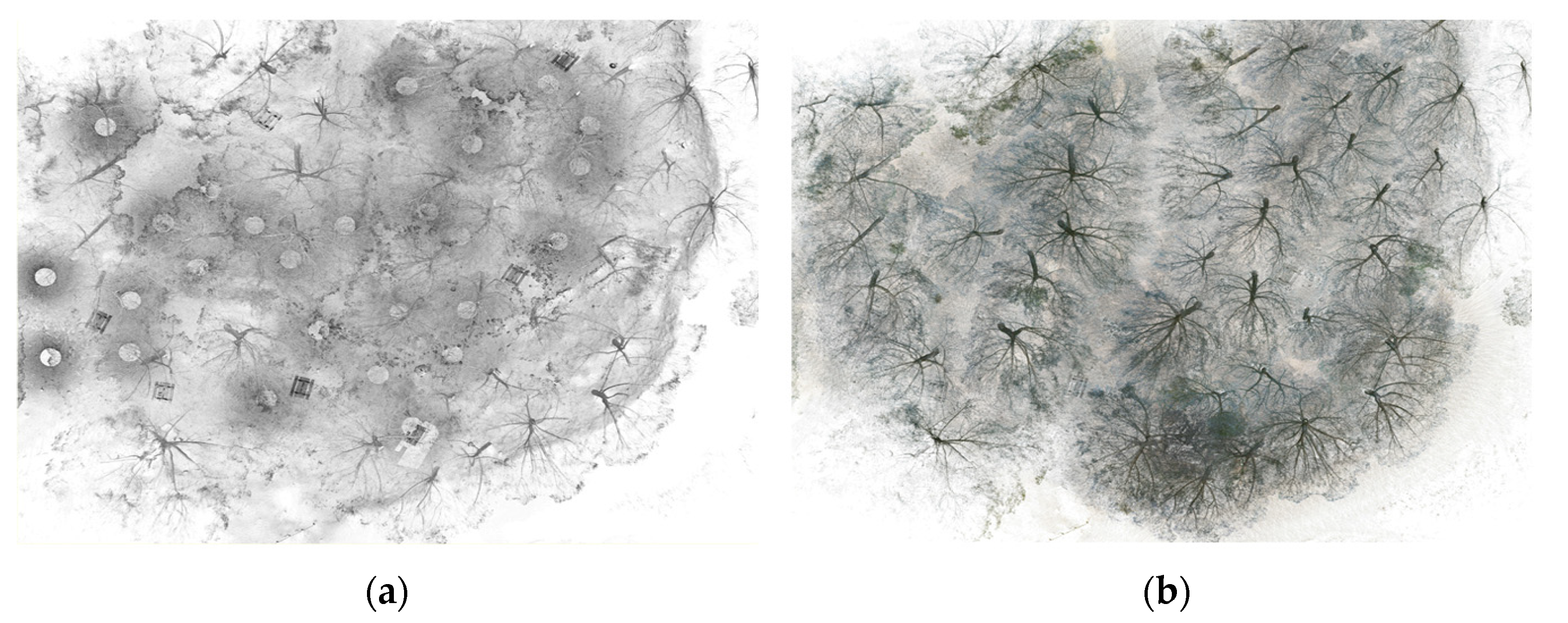
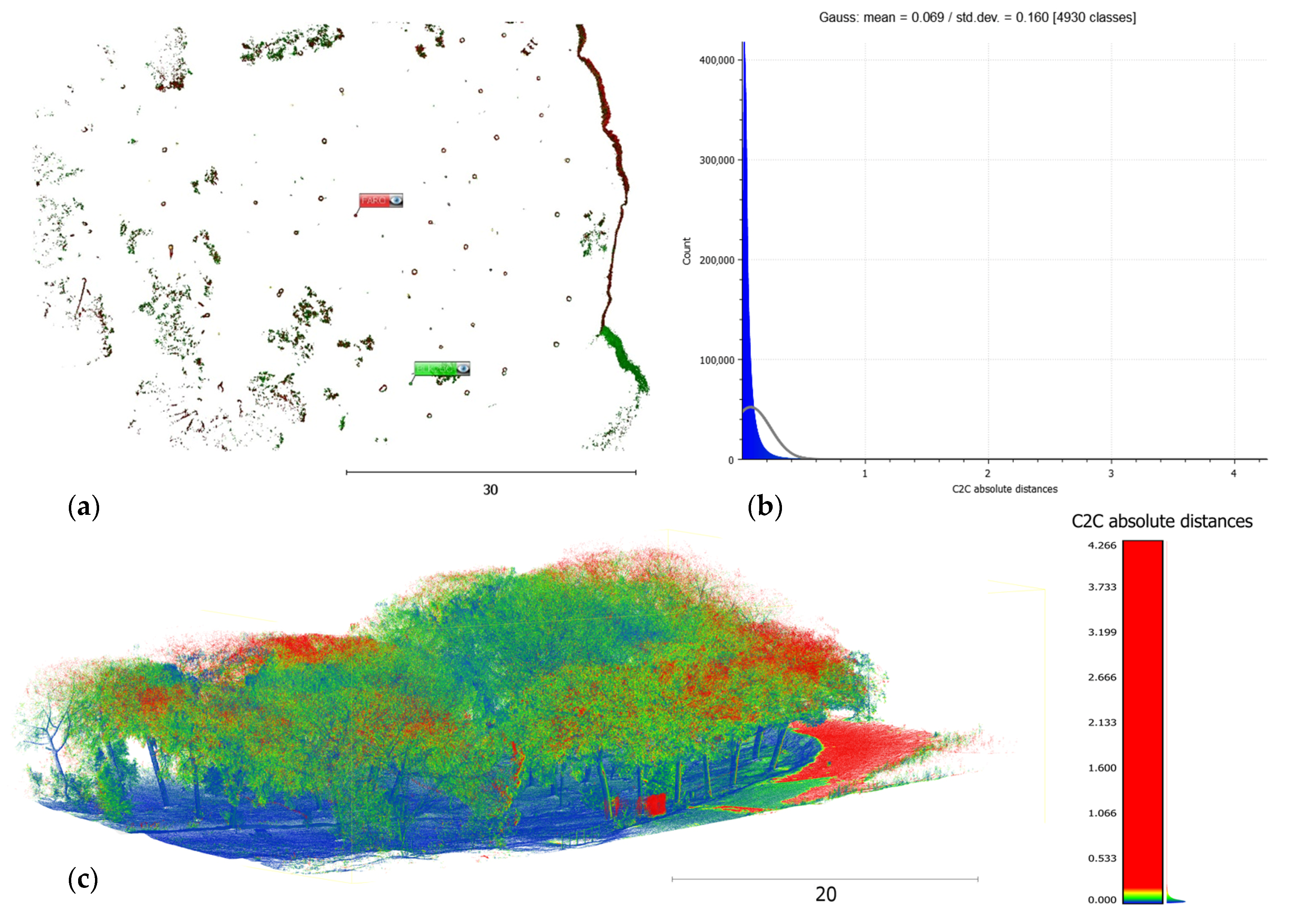
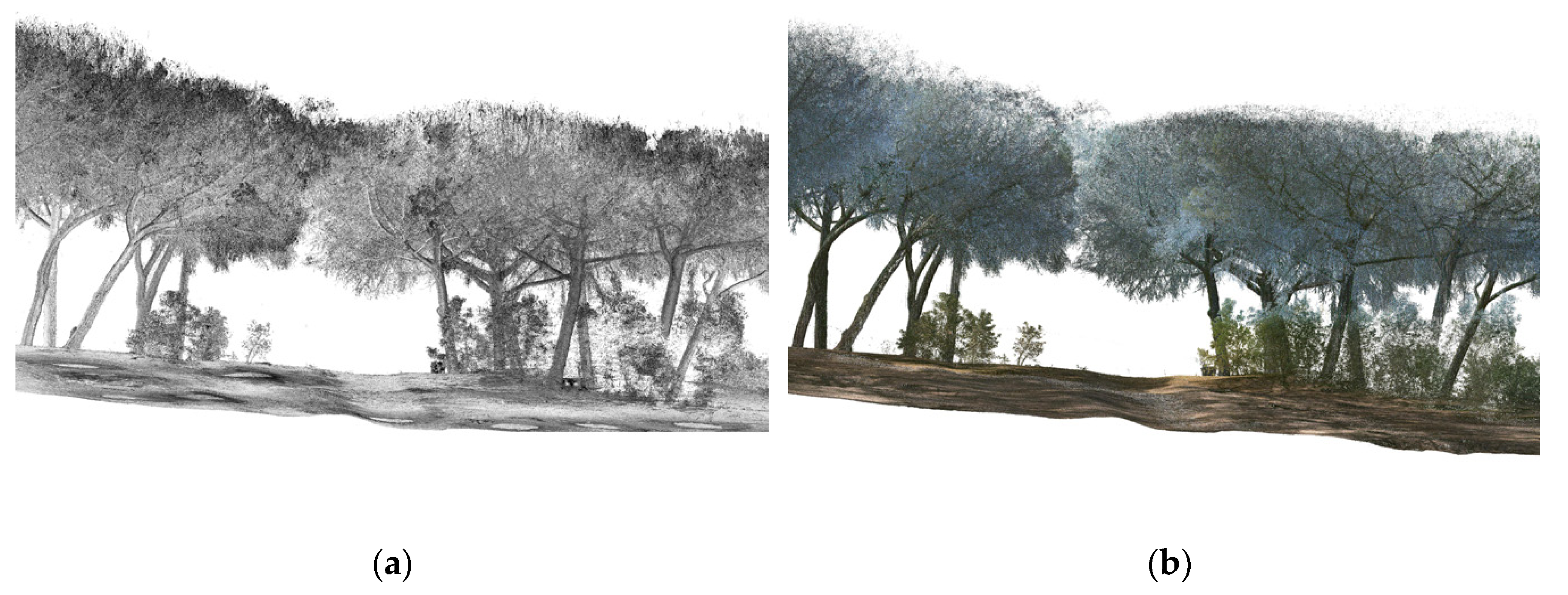

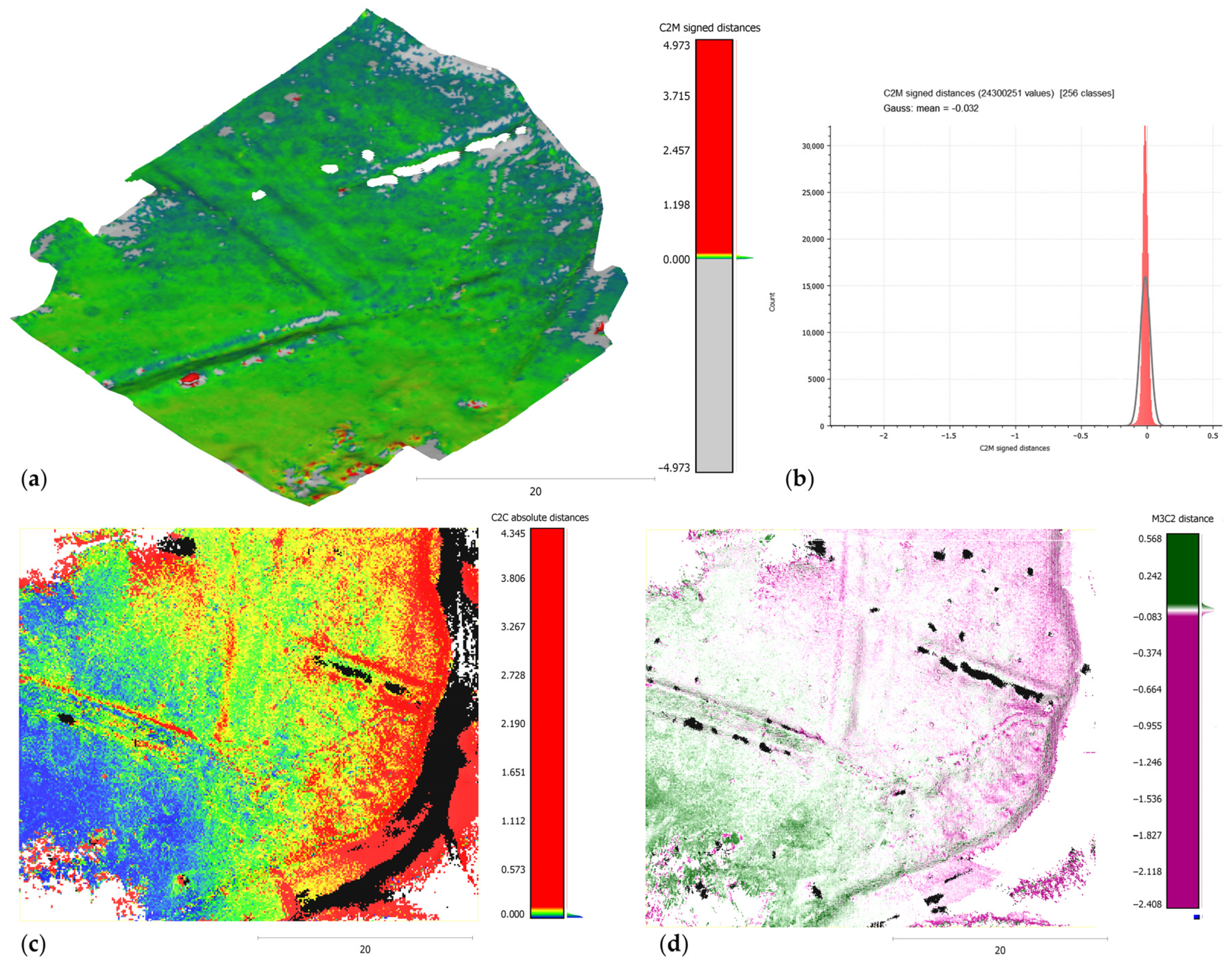
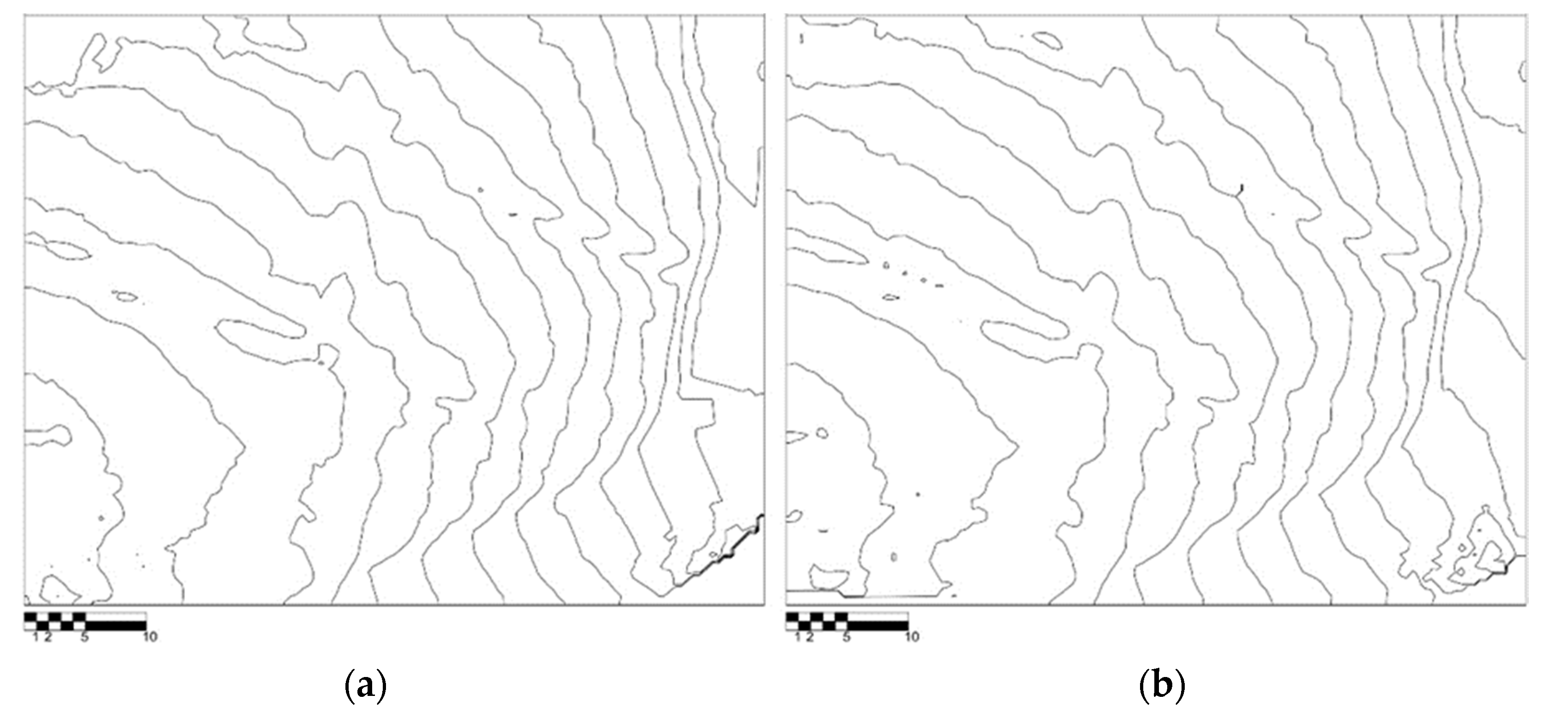

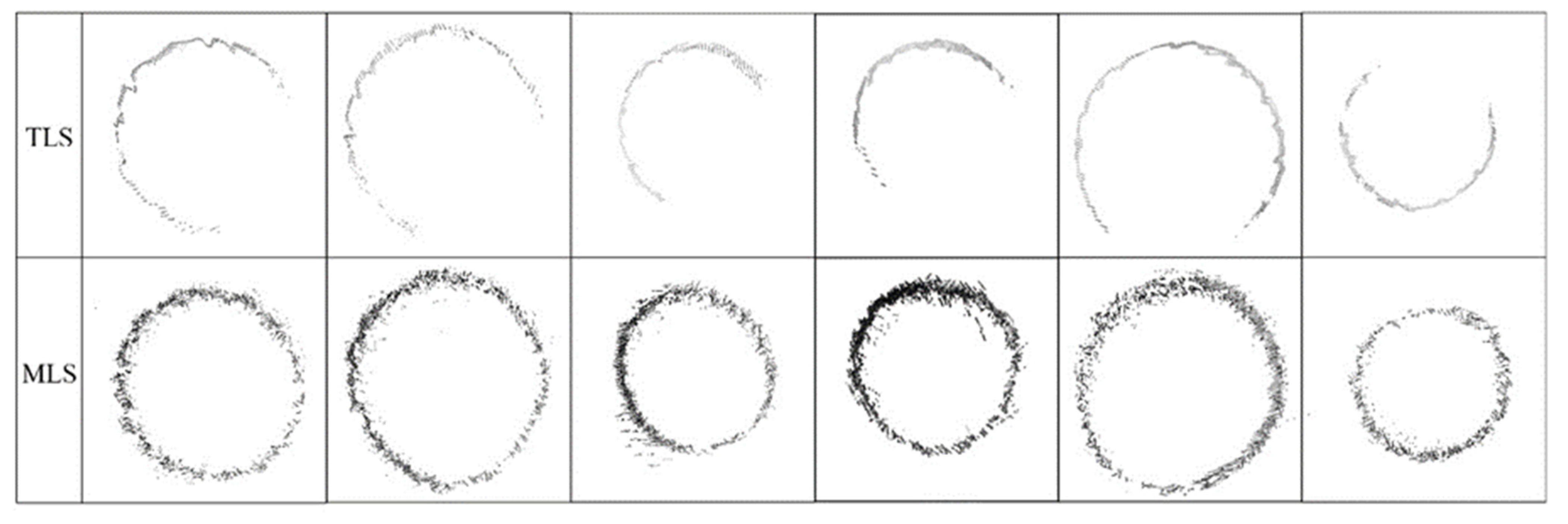
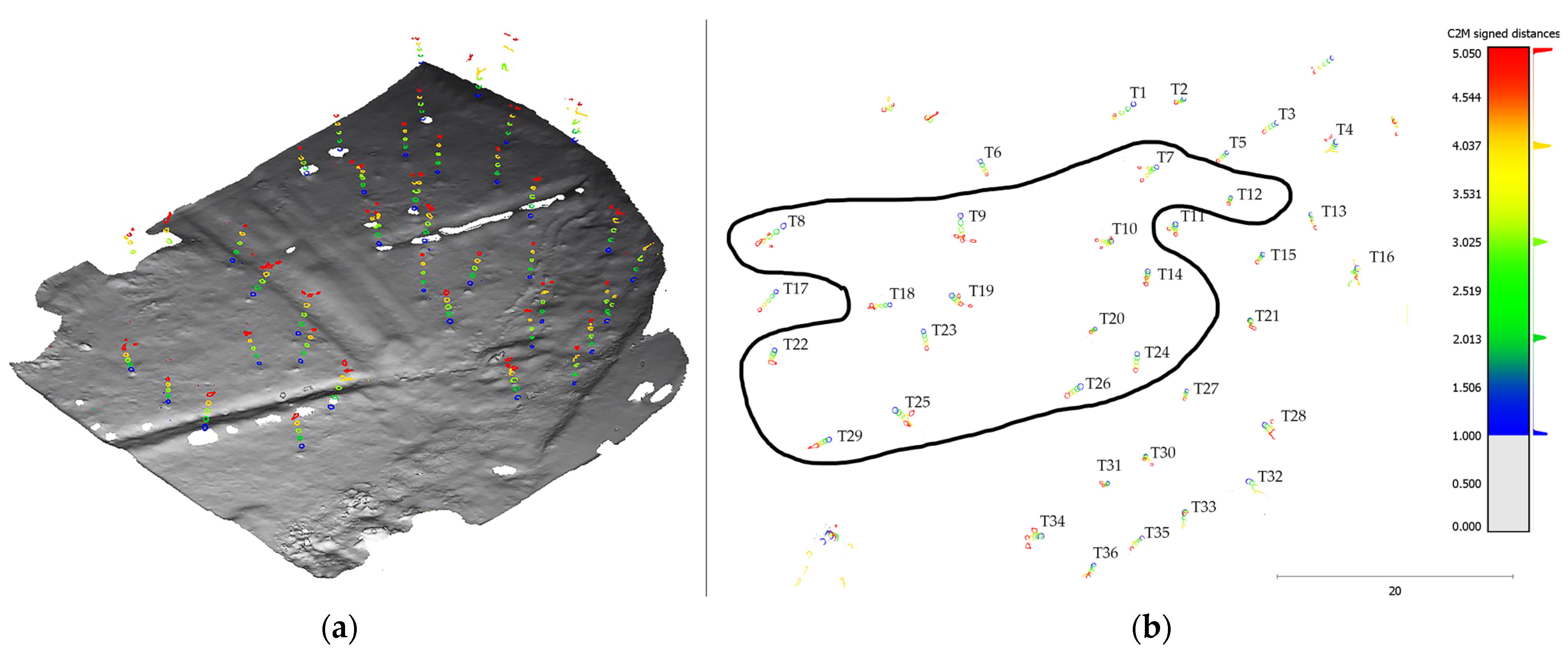
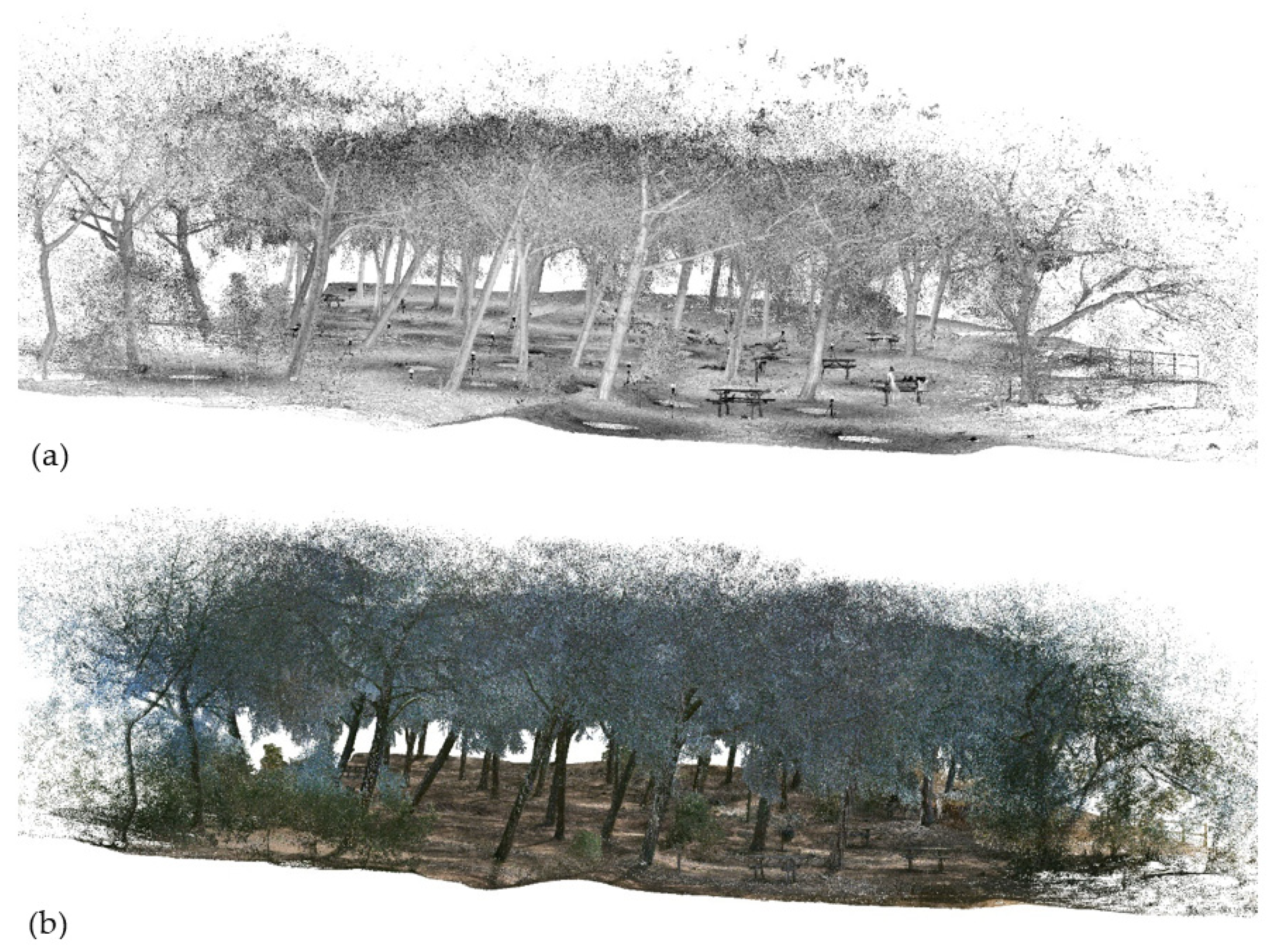
| Indicators | Faro 3D Descriptions | BLK2GO Descriptions |
|---|---|---|
| System | Phase-shift based | GRANDSLAM-based |
| 3D Position Accuracy | ±2 mm at 10 m and 90% reflectivity; 25 m at 10 m and 10% reflectivity | ±10 mm indoors |
| Range Noise | 0.6 mm at 10 m and 10% refl.; 0.3 mm at 10 m and 90% refl. | ±3 mm |
| Operating Range | 0.6–120 m | 0.5–25 m |
| Field-of-View | 360° (horizontal); 300° (vertical) | 360° (horizontal); 270° (vertical) |
| Point measurement rate | up to 976,000 points/sec | 420,000 pts/sec |
| Wavelength | 905 nm | 830 nm |
| Color Unit | Up to 70 megapixels in color | High resolution camera:12 Mpixel, 90° × 120°, rolling shutter |
| Operating temperature | +5 to +40 °C | 0 to +40 °C |
| Weight | 5 kg (including battery) | 775 g (including battery) |
| Slice Height from Terrain | 1 m | 2 m | 3 m | 4 m | 5 m | |||||
|---|---|---|---|---|---|---|---|---|---|---|
| Sensor Type | TLS | MLS | TLS | MLS | TLS | MLS | TLS | MLS | TLS | MLS |
| T1 | 83% | 100% | 84% | 100% | 85% | 100% | 75% | 97% | 87% | 95% |
| T2 * | 68% | 100% | 75% | 100% | 75% | 100% | 79% | 100% | 77% | 100% |
| T3 | 59% | 100% | 61% | 100% | 71% | 100% | 65% | 100% | 74% | 100% |
| T4 * | 61% | 55% | 63% | 53% | 61% | 52% | 55% | 53% | - | 51% |
| T5 | 85% | 100% | 85% | 100% | 85% | 100% | 81% | 100% | 81% | 100% |
| T6 | 93% | 100% | 93% | 100% | 91% | 100% | 84% | 100% | 78% | 100% |
| T7–T12, T14, T18–T20 | 100% | 100% | 100% | 100% | 100% | 100% | 100% | 100% | 100% | 100% |
| T22–T26, T29 | 100% | 100% | 100% | 100% | 100% | 100% | 100% | 100% | 100% | 100% |
| T11 | 100% | 100% | 88% | 100% | 73% | 100% | 100% | 100% | 100% | 100% |
| T13 * | 68% | 92% | 67% | 93% | 62% | 92% | 61% | 93% | 56% | 91% |
| T15 | 86% | 100% | 91% | 100% | 78% | 100% | 72% | 100% | 83% | 100% |
| T16 * | 64% | 76% | 66% | 63% | 72% | 60% | 30% | 65% | 63% | 50% |
| T17 | 100% | 100% | 100% | 100% | 91% | 100% | 91% | 100% | 100% | 100% |
| T21 | 100% | 100% | 100% | 100% | 92% | 100% | 91% | 100% | 100% | 100% |
| T27 | 87% | 100% | 100% | 100% | 100% | 100% | 88% | 100% | 80% | 100% |
| T28 | 78% | 100% | 73% | 100% | 73% | 100% | 64% | 100% | - | 100% |
| T30 | 100% | 100% | 100% | 100% | 100% | 100% | 97% | 100% | 95% | 100% |
| T31 | 90% | 100% | 93% | 100% | 100% | 100% | 100% | 100% | 100% | 100% |
| T32 * | 70% | 80% | 69% | 100% | 67% | 100% | 67% | 100% | 65% | 53% |
| T33 * | 79% | 100% | 63% | 100% | 63% | 100% | 64% | 100% | 62% | 100% |
| T34 | 65% | 100% | 63% | 100% | 66% | 100% | 65% | 100% | 67% | 100% |
| T35 * | 66% | 100% | 72% | 100% | 73% | 100% | 57% | 100% | 64% | 100% |
| T36 * | 85% | 100% | 83% | 100% | 82% | 100% | 83% | 100% | 83% | 100% |
| Total average | 82% | 95% | 82% | 96% | 80% | 95% | 77% | 69% | 75% | 93% |
| Average excluding trees marked by (*) | 88% | 100% | 89% | 100% | 87% | 100% | 84% | 99% | 83% | 99% |
| Issue N. | Issue Description | Impact Score if Used Faro Focus 3D from 1 to 5 [1 Low, 5 High] | Impact Score if Used BLK2GO from 1 to 5 [1 Low, 5 High] |
|---|---|---|---|
| 1 | Operators and equipment needed for site activities | 5 | 1 |
| 2 | Sensor operating range | 1 | 5 |
| 3 | Lack of geometric references on site | 5 | 5 |
| 4 | Site reduced visibility (due to plants and other obstacles) | 4 | 1 |
| 5 | Site access (uneven or steep terrain, caves, etc.) | 3 | 1 |
| 6 | Unstable ground surface (wet terrain) | 5 | 1 |
| 7 | Use of targets, spheres, or ground control points | 5 | 3 |
| 8 | Scans time set up | 5 | 1 |
| 9 | Scanning time | 5 | 2 |
| 10 | Light dependency | 1 | 5 |
| 11 | Colored scans | 4 | 1 |
| 12 | Scanner battery consumption | 2 | 5 |
| 13 | Scans with color | 5 | 1 |
| 14 | File size | 1 | 3 |
| 15 | Point cloud noise | 1 | 3 |
| 16 | Scans, cleaning, and filtering | 3 | 4 |
| 17 | Registration complexity | 5 | 1 |
| 18 | Tree attribute extraction and DTM creation | 5 | 2 |
| Total Average | 65 3.6 | 45 2.5 |
Disclaimer/Publisher’s Note: The statements, opinions and data contained in all publications are solely those of the individual author(s) and contributor(s) and not of MDPI and/or the editor(s). MDPI and/or the editor(s) disclaim responsibility for any injury to people or property resulting from any ideas, methods, instructions or products referred to in the content. |
© 2023 by the authors. Licensee MDPI, Basel, Switzerland. This article is an open access article distributed under the terms and conditions of the Creative Commons Attribution (CC BY) license (https://creativecommons.org/licenses/by/4.0/).
Share and Cite
Del Duca, G.; Machado, C. Assessing the Quality of the Leica BLK2GO Mobile Laser Scanner versus the Focus 3D S120 Static Terrestrial Laser Scanner for a Preliminary Study of Garden Digital Surveying. Heritage 2023, 6, 1007-1027. https://doi.org/10.3390/heritage6020057
Del Duca G, Machado C. Assessing the Quality of the Leica BLK2GO Mobile Laser Scanner versus the Focus 3D S120 Static Terrestrial Laser Scanner for a Preliminary Study of Garden Digital Surveying. Heritage. 2023; 6(2):1007-1027. https://doi.org/10.3390/heritage6020057
Chicago/Turabian StyleDel Duca, Graziella, and Carol Machado. 2023. "Assessing the Quality of the Leica BLK2GO Mobile Laser Scanner versus the Focus 3D S120 Static Terrestrial Laser Scanner for a Preliminary Study of Garden Digital Surveying" Heritage 6, no. 2: 1007-1027. https://doi.org/10.3390/heritage6020057
APA StyleDel Duca, G., & Machado, C. (2023). Assessing the Quality of the Leica BLK2GO Mobile Laser Scanner versus the Focus 3D S120 Static Terrestrial Laser Scanner for a Preliminary Study of Garden Digital Surveying. Heritage, 6(2), 1007-1027. https://doi.org/10.3390/heritage6020057







